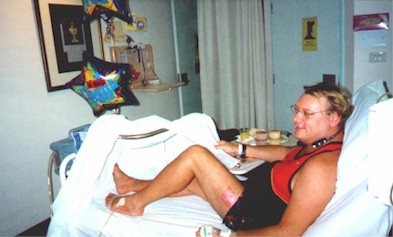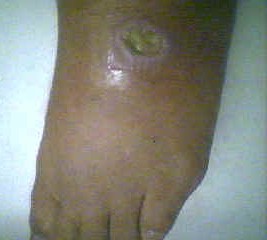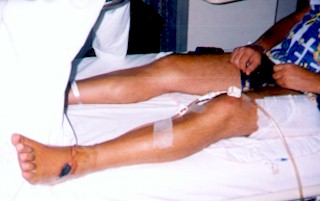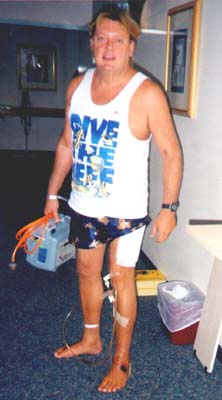First-Person Report on Diagnosis
and Treatment of Secondary
Infection of a Stingray Wound

One of the great things about maintaining a website such as this is the opportunity to help people. Most requests for help are from students, journalists, or documentary film-makers who want help with this-or-that shark- or ray-related project. To the question-askers, their needs may seem to be of paramount importance and urgency. But, in truth, nothing really terrible would happen if I were simply too busy to respond and most would quickly forget they had asked me. However, every once in a while, along comes an opportunity to help someone with something truly urgent and important. One such opportunity came via E-mail on 23 January 2002:
 Help!
I have been stung by a stingray on the top of my foot in Sydney Australia 7
weeks ago. I have been to 3 different doctors and have been given all sorts
of antibiotics which initially kept the problem of swelling in hand but has
not cured the problem I currently have. The wound area has become ulcerated
due to ice being used instead of an initial hot water - bleed treatment to
remove toxins.
Help!
I have been stung by a stingray on the top of my foot in Sydney Australia 7
weeks ago. I have been to 3 different doctors and have been given all sorts
of antibiotics which initially kept the problem of swelling in hand but has
not cured the problem I currently have. The wound area has become ulcerated
due to ice being used instead of an initial hot water - bleed treatment to
remove toxins.
My dilemma now is to either have a clean and skin graft of the area, or keep using the cure that was given by a Fijian doctor (who knew his stuff) on my recent annual holiday, by keeping the wound under a cover of OpSite (a clear skin type of cover) with gel of IntraSite (a clear gel used to draw out foreign bodies and pus etc.) this method will take around 6 months or more and has improved in the last 2 weeks.
I am unsure of which path to go down, either the Hospital for a week with a skin graft (which I don't really want to do) with a somewhat shorter recovery period, or to continue with the current - responsive method for the next 6 months or so, of using OpSite and IntraSite. ( I would need to wear thongs for this period - which is not an issue at work).
Attached is a current BMP file photo of my foot. ( Note that there is still a lot of swelling )
Please - what would you suggest that I do.
John Pearce -
Sydney Australia.
Within an hour of receiving John's E-mail, I sent the following response:
Hmmm. I'm sorry we had to 'meet' under these circumstances.
First things first, I should state — for the record — that I am not a physician. The best I can do is pass along a distillate of my best advice based on what I've managed to learn from the scientific/medical literature on stingray spinings and some common-sense advice drawn from my and my wife's experiences with marine first aid.
To answer your primary question as directly as I can: if your wound is showing significant improvement over the past two weeks, it seems prudent to avoid the risks of surgery — including (but not limited to) the bodily stresses of general anesthesia, the surgery itself, and the delay that is likely to be associated with a skin graft. If your current treatment seems to be working, why not give it another month and see what happens?
It is disturbing — to say the least! — that your wound hasn't healed. This leads me to suspect three, rather serious (and by no means mutually exclusive), possibilities: there may be, 1) pieces of the stingray barb still in your foot, and/or 2) some level of bone ulceration taking place, and/or 3) secondary infection of your tissues with marine bacteria. If 1 or 2 are the case, it might be a good idea to have your injured foot X-rayed, to make absolutely certain no pieces of the barb remain in the wound and to check for inflammation or degeneration of bone and/or associated connective tissues. If 3, your treatment becomes rather complex.
Beyond this (admittedly non-expert) advice, I would encourage you to share the information presented below with your physician.
Wounds acquired in the marine environment frequently become infected. Marine bacteria thrive on the skin of marine creatures and in ocean water — including Staphylococcus spp. (Staph), Streptococcus spp. (Strep), Mycobacterium marinum, and Vibrio spp. — which can cause very serious illnesses if allowed to proliferate in a wound. Marine infections can be difficult to diagnose and manage, often requiring different culture methods and broader antibiotic coverage than non-marine infections.
In All Stings Considered (University of Hawaii Press, Honolulu, 1997), Craig Thomas, MD, writes:
"In healthy people with minor marine infections, Staph or Strep are the most likely culprits. Apply mupirocin ointment three times a day for superficial Staph and Strep infections. For localized redness and swelling, add cephalexin, 500 milligrams four times a day. This antibiotic is usually effective and is not photosensitizing. If the infection persists or worsens, or if blisters develop, continue the cephalexin and add doxycycline, 100 mg twice a day, or ciprofloxacin, 750 mg twice a day. This regimen covers the marine organisms most likely to to be causing infection."
"Patients with rapidly spreading infection, fever, or generalized illness may need intramuscular or intravenous therapy. Consider ceftriaxone, 2 grams a day with either doxycycline or coprofloxacin. Do not wait for culture results to begin treatment."
"A severe infection with blisters may mean a life-threatening Vibrio infection. [Note from R. Aidan Martin: several species of Vibrio are a normal component in the tissues of stingrays, because they play a vital role in metabolising urea. It is therefore quite possible that some species of Vibrio may have been introduced into your wound.] ... Slow-growing nodules suggest Mycobacterium marinum."
Thomas' medical reference for all this is:
Millington, J.T., and P. Wilhelm. 1993. Marine Microbiology of Rocas Alijos. Journal of Wilderness Medicine, 4(4): 384-390.
On the matter of Vibrio infections, Dr. Thomas has this to say:
"Suspect Vibrio in patients with severe, rapidly advancing cellulitis, bullae, and in those with liver disease or damaged immune systems. Vibrio wound infections can rapidly progress to necrosis [R. Aidan Martin here: from the photo you sent, some level of tissue necrosis may well be occurring], requiring surgical debridement or amputation." ...
"In all suspected Vibrio infections, start antibiotics immediately. Do not wait for culture results. Initial therapy must include Staph and Strep coverage. Use a third-generation cephalosporin, such as ceftazidime, and doxycycline."
"For confirmed Vibrio infections, two studies recommend doxycycline, 100 milligrams twice a day, or tetracycline, 500 milligrams four times a day. Ciprofloxacin, 750 milligrams two times per day, has also successfully treated Vibrio wound infections. Chloramphenicol is an acceptable alternative."
"Culture Vibrio organisms from blood, wounds, and stool. Use selective culture media with 3 percent salt content. Thiosulfate citrate bilesalts sucrose (TCBS) is a good medium for growing marine Vibrio species."
The two studies that recommend doxycycline for treating Vibrio infections are:
Hlady, G.W. et al. 1993. Vibrio vulnificus from Raw Oysters: Leading Cause of Reported Deaths from Food-Borne Illness in Florida. Journal of the Florida Medical Association, 80 (August): 536-538.
Limpert, G.H., and J.E. Peacock. 1988. Soft Tissue Infections Due to Noncholera Vibrios. American Family Practice, 37 (February): 193-198.
The study that treated successfully a Vibrio infection with Ciprofloxacin is:
Meadors, M.C., and G.A. Pankey. 1990. Vibrio vulnificus Wound Infection Treated Successfully with Oral Ciprofloxacin. Journal of Infection, 20 (January): 88.
Another, somewhat older, source — A Medical Guide to Hazardous Marine Life by Paul S. Auerbach, MD (Progressive Printing, Jacksonville, 1987) — had this to say about marine infections:
"The antibiotics to use are trimethoprim-sulfamethoxazole (Bactrim or Septra) in a dose of one double-strength tablet by mouth every 12 hours (or twice a day) OR tetracycline in a dose of 500 mg by mouth every 6 hours (or four times a day). Either of these antibiotics might cause a 'photosensitive' person to be more prone to severe sunburn, so caution (and an adequate sunscreen, with SPF 15 or greater) must be applied in ultraviolet (sun) exposure. Always ask a victim whether he is allergic to any medications; if he specifies an allergy to 'sulfa drugs', then trimethoprim-sulfamethoxazole should not be used. ... Popular antibiotics which are not effective for many marine infections are penicillin, erythromycin, and cephalexin."
That's about all the advice I can give you on your stingray wound infection. I hope that at least some of this will be of help. I wish you as speedy and complete a recovery as possible and hope you will drop me a line to let me know how things work out.
On 26 April 2002, John wrote again to bring me up to date on his progress:
I know its been a long time since we last spoke and I must say that I do appreciate you quick response to my email. Remember me, the guy that go stung by a Sting-Ray on the foot and I sent you a web cam shot of it. Well there has been a lot gone on since then.
 20 days in hospital due to your absolutely correct
diagnosis of the 3 thing to watch out for.
20 days in hospital due to your absolutely correct
diagnosis of the 3 thing to watch out for.
1 - Staphylococcus
2 - Streptococcus
3 - Mycobacterium
Well in short I had the lot
Staph Aurous
Strep Group G
Mycobacterium Marinum
That was after the 1st Operation then the doc tried to apply the Skin graft - which didn't take at all due to all of the above.
10 days on 4 hour IV drips of 3 different drugs + one Oral a couple of times a day, then another Operation, then another skin graft, which this time it actually took. I had to tell the doc to put my foot in a 1/2 cast so that I could not move it and to do "this and that" - and this surgeon had swapped someone's whole hand from the left to the right hand etc. He was suppose to be the best. They only found out about all the infections one they did the tests on the samples from the Operation - although they already knew that I had Strep Group C at that time not G etc.
Attached are a number of photos from Hospital just after the 1st OP and with the IV Drip after.
The patch on my Left thigh is were the 1st skin graft was taken then there was 1 more next to it for the 2nd OP a lot smaller - as I told the Doc what the hell to do.
Then all went fine - now its the size of 1 of your Dimes (US $) and the Skin Graft was the most painful part of the whole thing.
If you need to know any more or want more photos please email me. Thank You once again for all of your help - do say hi to your wife. Thank You - Thank You.
On 10 December 2002, after several intermediate reports from John updating me on his recovery, I wrote him again to learn more about how, when, and where the injury occurred and asked his permission to share his story via this website. over several days, he responded as follows:
.jpg) Here, as promised yesterday, are the photos from
when my foot was probably at its worst, which was about 3-4 weeks after
"the accident".
Here, as promised yesterday, are the photos from
when my foot was probably at its worst, which was about 3-4 weeks after
"the accident".
These photos were taken in Fiji, by a couple of Americans while I was there on holidays with my best friends and staying at there house in Fiji. It shows the wound after seeing 3 different doctors in Sydney and having antibiotics for the full 3-4 weeks. Once I arrived at the island (Musket Cove) the owner of the resort took me to her doctor on the mainland for treatment, the wound was always weeping and the Fijian doctor suggested that I return to Australia for treatment, but after spending so much money to get there and the wound had not changed at all - I decided to stay and deal with it in 2 weeks when I returned to OZ. His suggestion was to use Opsite and Intrasite on the affected area. Intrasite is a type of clear gel and Opsite is the (plastic) covering to seal the wound.
_closeup.jpg) I went to see the Doc again a week later and he
said that it was OK to stay for another week (the duration of my Holiday)
but asked me to see an orthopaedic Surgeon. He said that for such a small
wound they would probably not want to touch it and this was the case I found
upon returning to Sydney. As you may know - I ended up seeing a
Reconstructive Plastic Surgeon who did the operation on the area - but
stuffed up by not getting biological results before operating, thus the
second (successful) operation after treating the infections of
Staphylococcus
Aurea, Staphylococcus Group C which turned into Staph G and Mycobacterium
Marinum. Once these were under control then the 2nd skin graft and surgery
took just fine.
I went to see the Doc again a week later and he
said that it was OK to stay for another week (the duration of my Holiday)
but asked me to see an orthopaedic Surgeon. He said that for such a small
wound they would probably not want to touch it and this was the case I found
upon returning to Sydney. As you may know - I ended up seeing a
Reconstructive Plastic Surgeon who did the operation on the area - but
stuffed up by not getting biological results before operating, thus the
second (successful) operation after treating the infections of
Staphylococcus
Aurea, Staphylococcus Group C which turned into Staph G and Mycobacterium
Marinum. Once these were under control then the 2nd skin graft and surgery
took just fine.
Personal History:
I am 41 at present and was 40 when the "Accident" occurred DOB: 4th February 1961.
I have had a Cash Register Company for many years (since I was 21) but 7 years ago I sold it as I was over-it and started a career in IT for a Sydney based Bank doing shift work. At the same time my then, other half, wanted me to have a business and only really knowing Cash Registers decided to just Hire them. We produced a great business starting with 2 borrowed Cash Registers and after 4 years owned about 90. Since we split up we also split the business and therefore I now own and run "AAA Cash Register Hire" while at the same time working for the Bank.
I start at 7:30am daily, now that I am not on shift work and finish at 3:30pm which gives me time to Pick-up and Deliver Registers to people when required.
At the Bank, starting out in 1996 on the helpdesk monitoring ATM's quickly moved onto second level support repairing PC's and nutting out problems.
Now, for the last 2 and a half years I work in the third level support called Desktop Services and make programs for over 7 thousand PC's bank wide, as well as still work out problems that occur with user accounts, Programs, Networking and Viruses. I do very much enjoy this work as we get to play with the latest programs/software and Hardware. There are 7 of us that look after Sydney and 3 in Adelaide (South Australia).
The Accident:
Well, as I recall, I was out on a 46 foot yacht watching my best mate's son (12 yo) racing in the state finals of there sailing club. This was in a Bay about 25 kilometres (15.6 Miles) south of Sydney, called Gutamulla Bay. We came in for lunch to the shore by a small motor boat as the keel of the yacht was far too deep to get anywhere near shore. About an hour or so later we were going to get back on the motor boat to go back out to the Yacht but during lunch the tide went out and there was a very large sand bank which when out for at least 800 yards so we were walking in water up to our knees for about 500 yards to get to the motor boat. We were told that the area is known for stingrays and to keep an eye out for them, but it was hard to see as there was sea weed and so on. So I thought that I would travel in the foot steps of my mate who was in front of me, but his youngest son was mucking up and he went right to go and get him. I was only about 20 yards from the boat and it was my Very Last Foot Step before getting onto the boat that it felt like someone had got a pen and stabbed me on the top of my foot as hard as they could. Of course I screamed and jumped about 4 foot in the air. The fellow on the boat said "what is it" I thought for a moment as all of these thoughts of what it could be, went through my mind. I thought Fish - NO, Prawn-NO, Lobster-NO, Shark-NO, Must be stingray. The fellow asked me to lift up my leg, which I did and the Blood was almost spraying out and would not stop. When on the boat they poured Fresh water on it and wrapped it in a towel. We then went back to the Yacht and I was in a hell of a lot of pain - so I asked for a number of white wines which I swiftly drank. Meanwhile, to stop the bleeding my mate got ice, with the agreement of all on board (including myself) and wrapped my foot in it.
Later on, I am not sure if you told me or I read it somewhere that was the wrong thing to do. I should have put it in a bucket of hot water for at least an hour to let it bleed and remove all of the toxins, (Great in hind sight).
 About 4 hours later we went to a medical centre. By
this time the wound area was numb and the doctor had a look to try and find
a barb, to no avail. He put me on some antibiotics and sent me on my way.
The next day a was playing Life Guard for a friends 7yo pool party, the
wound was still a bit sore but the whole area of my foot was blue from
bruising, mainly the ankle area and was also swollen a little. A day or 2
later it was still a bit blue but felt fine. A few more days later when I
had used all of the antibiotics the second day off them and the foot started
to feel a little sore but did not bother me and looked OK. The next day it
was even worse and I went to another doctor and explained what happened and
received more antibiotics. After a week using them I went back to the second
doctor and was prescribed more, by this time the wound had started to open
up to the size of your little finger nail. Another week went by and I
decided to go to another doctor and explain the events to date - more
antibiotics....
About 4 hours later we went to a medical centre. By
this time the wound area was numb and the doctor had a look to try and find
a barb, to no avail. He put me on some antibiotics and sent me on my way.
The next day a was playing Life Guard for a friends 7yo pool party, the
wound was still a bit sore but the whole area of my foot was blue from
bruising, mainly the ankle area and was also swollen a little. A day or 2
later it was still a bit blue but felt fine. A few more days later when I
had used all of the antibiotics the second day off them and the foot started
to feel a little sore but did not bother me and looked OK. The next day it
was even worse and I went to another doctor and explained what happened and
received more antibiotics. After a week using them I went back to the second
doctor and was prescribed more, by this time the wound had started to open
up to the size of your little finger nail. Another week went by and I
decided to go to another doctor and explain the events to date - more
antibiotics....
At this stage I was going to Fiji for my annual holiday and when I arrived the resort owner took me to her doctor on the mainland - and I think that you have the rest in previous emails.
What an epic Hey!
The Stingray:
That long shot you were talking about - your right - I have no idea - BUT - it would have been one of those smallish stingrays about a foot, foot and a half in diameter.
Oh - almost forgot - apparently this is a typical way to get stung - being out in shallow water when the tide is going out. When I was at Rose Bay a few weeks ago, in Sydney Harbour I was standing on the side of a Walf and looked down (again when the tide was going out) and saw 2 stingrays in about 1 foot of water, they just sort of shook themselves and instantly were covered by sand. All I could see was the eyes sticking up and a bit of there tail. Unless I actually saw this - there would be no way that you would know that they were there. And yes it brought back memories - hideous memories.
Like I said use whatever you like, my full name, address whatever. I will get that photo of the healed graft ASAP to you.
John is now recovered fully and glad to be up and about. John was as good as his word and sent me photos of his healed graft. His foot looks much better now, but the memory of this whole nasty affair has not yet faded. But John does not seem to blame the stingray in any way for his injury. The ray was just defending itself to the best of its ability. it may seem that the real culprits here are the marine bacteria responsible for John's secondary infection. But one cannot really blame them, either. Their activity allowed John's wound to fester, but it was nothing personal. John's wound simply provided the bacteria an ideal living space. The rest, as they say, is history ...
I would like to thank John Pearce for his willingness to share details and photos of his stingray injury, secondary infection, and recovery.
